The Wedgwood neighborhood is only a mile-and-a-half from the (former) Naval Air Station at 7400 Sand Point Way NE in Seattle. There was much available land in Wedgwood in the 1940s for housing, so during World War Two a lot of military families came to live in Wedgwood.

Shearwater barracks buildings were on several sites near NE 77th Street and from 40th to 43rd Avenues NE in Wedgwood. Photo used by permission; do not copy.
In 1945 the Seattle Housing Authority sought a site to build housing for civilian or military workers of the naval base, and they acquired what is now the Decatur School block, and some surrounding blocks around NE 77th Street and 43rd Ave NE. A complex of barracks buildings with a total of 315 living units was built. In 1948 the Shearwater Housing in Wedgwood was turned over to the Navy for exclusive use of residence for personnel assigned to the naval base at Sand Point.
This historic event, the military housing era in Wedgwood, is remembered by a Wedgwood resident, Cynthia, who came to Seattle with her parents in 1956 when her father was assigned as a Chief Petty Officer at the Naval Air Station-Seattle. Here Cynthia tells her story.
Cynthia’s story
“My father, Tiburcio, came to the USA at age 18 in 1929 to seek a better education, but because of the economic depression which began that year, he joined the countless migrant workers searching for work in the USA.
“Even though the United States did not officially get involved in World War Two until the Pearl Harbor attack in December 1941, earlier that year it was known that military of the Empire of Japan were threatening the Philippines and other island nations. For this reason, in July 1941 President Franklin D. Roosevelt called for Filipinos to join the U.S. military to help defend their nation.
“My father enlisted in the U.S. Navy in 1942 and transferred from Columbus, Ohio, to Seattle in 1956. Because of my father’s rank as a Chief Petty Officer at the Naval Air Station, our family was assigned to live in one of the larger three-bedroom apartments in the Shearwater barracks buildings on 43rd Ave NE in Wedgwood.
“In 1948 President Harry S. Truman had issued Executive Order 9981 which abolished discrimination “on the basis of race, color, religion or national origin” in the U.S. Armed Forces. The Shearwater housing where we lived was not segregated; all colors and military rank levels were represented. There were a number of mixed-race families such as black men or white men with Japanese wives. There were quite a few Filipino families.

Decatur School class photo showing racial diversity. Photo courtesy of the Seattle Public School Archives.
“Shearwater was an enclave of multiculturalism in what had been an almost-all-white neighborhood in Seattle north of the Ship Canal, the demarcation line for the discriminatory policies of “redlining” to keep people of color out of white neighborhoods.
“My family frequented the Wedgwood-area stores and businesses and attended local schools. In growing up, I did not know that many people of my color and background could not feel comfortable in north Seattle.
“I was fortunate to have the connection with the Naval Air Station on Sand Point Way NE. Our family had commissary and Px privileges, we watched the current movies at the theater for only 25 cents, and I really liked it when my dad was saluted by the guards when we entered the Base.
“My father’s job as a Chief Petty Officer was to provide leadership, bridge the gap between officers and enlisted men, train newly-commissioned junior officers, and give instruction in technical skills. The rank of Chief Petty Officer is equivalent to sergeant first class in the U.S. Army.
Life in the Shearwater community
“Because of my father’s rank and status as an officer, our apartment at Shearwater was a gathering place especially for homesick Filipino sailors who would come for a taste of home cooking and a chance to speak the language. My mother Consolacion organized events and parties at the Shearwater Community Hall (the Decatur Annex on NE 77th Street at the corner of 43rd Ave NE).
I recall the Filipino sailors who taught me how to dance the cha cha at Shearwater Hall. The sailors played softball with the children and enjoyed traditional Filipino dishes such as dinuguan and adobo. They gave us a stronger sense of “back home” in our cultural heritage.
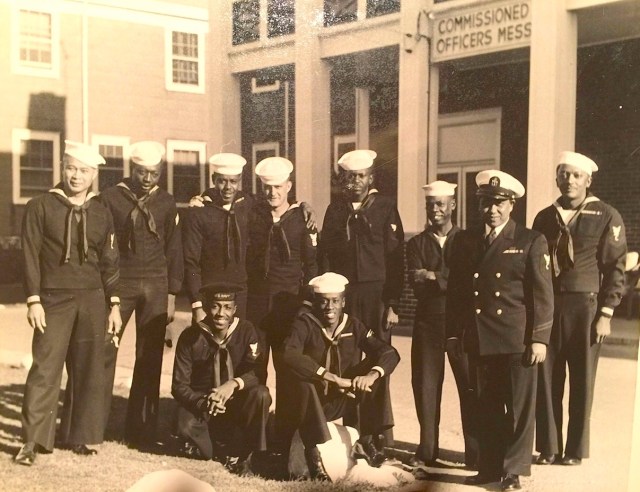
Cynthia’s father with his crew at the Naval Air Station on Sand Point Way NE in Seattle. Photo used by permission; do not copy.
“I can still see the Shearwater Community Hall (Decatur Annex) in my minds-eye as an active and functional gathering place for the Shearwater Housing Project families. Shearwater stands also to convey the importance of preserving the non-white identity in a city that is primarily white.
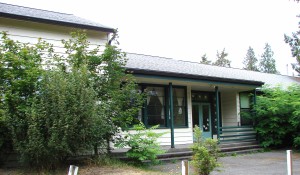
The Decatur Annex, the former Shearwater Hall, faces NE 77th Street nearest to the corner of 43rd Ave NE in Wedgwood. Photo by Valarie.
“Efforts in the years 2018-2019 to preserve the Shearwater Hall/Decatur Annex as a cultural site were not successful, which is very sad.
“The Shearwater Hall/Decatur Annex is a building which brought me much joy and a deep connection to the neighborhood. I have a great desire to express my love for that site, the community, the U.S. Navy, and the Naval Air Station where my dad worked, where I watched countless movies with the audience standing for the National Anthem before the movie was shown.
“The Shearwater Housing Project closed in 1965 and all of the barracks were demolished in 1966. The community center building on NE 77th Street at 43rd Ave NE was left standing and was used by Decatur School (as an auxiliary building) until 2016.
“If all of the people who entered the Shearwater Community/Decatur Annex over the years from 1945 to 1965 had all signed their names somewhere on the premises, you would see a collage of signatures. Each signature would represent a purpose, a story for socializing, working, eating delicious food, enjoying community life and like me, for dancing in that building.”
Sources:
Cynthia’s story as told to Valarie for this article. Our thanks to Cynthia and to Ruth, the Wedgwood resident who prepared a historic preservation report about the Decatur Annex building, which was presented to the City of Seattle Landmarks Board.
At the final vote at Landmarks Board on January 2, 2019, the nomination did not get enough votes to succeed, and for this reason the Decatur Annex building was demolished in July 2019.
Cynthia and Ruth are following up by creating historic narrative curriculum material about the Shearwater years. They are advocating for the School District to create a historic site marker on the corner near the big tree at 77th & 43rd.
Photos: all photos courtesy of Cynthia and used by permission. DO NOT COPY.
City of Seattle Landmarks Board info about historic preservation.
The Shearwater Community Center/Decatur Annex nomination report was presented at Landmarks Board on January 2, 2019.
Decatur School history.
“Segregated Seattle,” essay on the website of the Seattle Civil Rights and Labor History Project, University of Washington Special Collections.
Shearwater history: series of articles on this blog, Wedgwood in Seattle History, about how the Shearwater housing was built in the Wedgwood neighborhood and what happened to it.
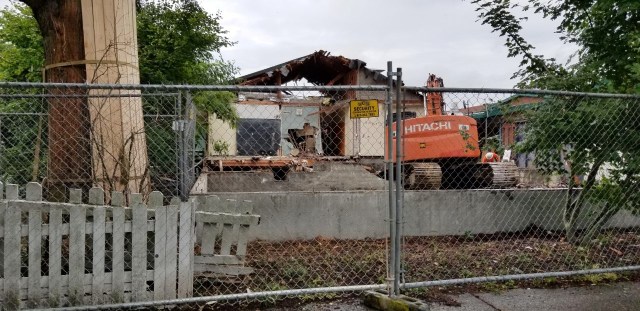
Our efforts to preserve the Decatur Annex building as a historic site, were not successful. Here we see demolition of the building during the week of July 8, 2019, as viewed looking westward from 43rd Ave NE. At left is the cedar tree at the corner of NE 77th tree and 43rd Ave NE which is being protected with fencing, to be preserved. At right is the Decatur School building.

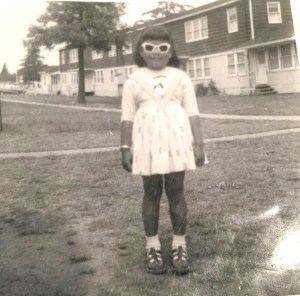

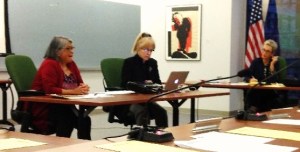
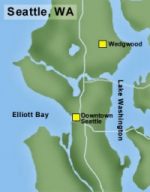
Pingback: People in Preservation: A Look Behind a Landmark Nomination - Historic SeattleHistoric Seattle